Travelling in Costa Rica
22 Dec. 2006 – 16 January 2007
About Costa Rica
Caribbean coast - Limon Province
San Jose, the capital
Pacific coast – Guanacaste Province, Tamarindo
- watching the Leatherback turtle nesting
Arenal Province - La Tigra
Some facts about Costa Rica
CR is a small country in Central America bordering Nicaragua to the north and Panama to the south. It is close to the Equator (Lat. 10’ N, Lon. 83’ W - you can see what we’ve learned sailing). The population totals just less than 4 million. It is divided into seven provinces and the climate varies enormously, even within these. About 25% of the country is designated as national parks, biological and forest reserves and protected zones.
CR is cast as a paradise for ecotourism. Yes, but the environmental problems are manifold - and not all of the country’s making. Visitor numbers declined by 1-2% in 2006. The Americans (and others) use the country as their neighbouring paradise, acquiring land and property at an alarming rate.
At the global level, the El Niño weather pattern (and global warming) affects the region and country, meaning less rain during the May-November rainy season and drought emergency. Predictions are for another El Niño. In the short term the tourist industry benefits, since the high/dry season is longer, the roads are passable rather than washed out, etc. 2005 did have a reasonable wet season and we are told that we’re here at the most beautiful time of year.
At the local level, problems are enormous: massive construction of condos and palatial houses in gated communities, often without proper permits and with scant regard for the environment. Around Tamarindo (see below), mangroves are being drained for that desirable ocean view and access; restaurants, some hotels and residences dump waste water directly into the streets and the sea, and the roads are often in bad shape*. Recycling facilities are scarce. Corruption and bureaucracy at municipal and provincial level as well as (mostly) petty crime add to a less favourable picture of this tourist paradise. The newly elected President Oscar Arias recently stated that “Tamarindo and Manuel Antonio (the country’s smallest national park on the Pacific Coast) were already lost…” We do not see constant manifestations of this but an eloquent, hard-hitting alternative press is very instructive.
*From the Tico Times 22 Dec. 2006:
“Swallowed Taxi: A taxi driver suffered only minor injuries when the Isuzu Troper he was driving plunged into an unmarked, two-meter deep by three-meter wide pothole near Nicoya, in the northwestern province of Guanacaste in late February. The Trooper had to be removed with a crane”.
There is also good news:
Municipal government and community associations are becoming increasingly assertive, taking the lead in environmental awareness, recycling, bridge and road repairs – but state funding is not easily obtained.
Following the inauguration of President Arias in May, 20+ new women parliamentarians were sworn in, giving Costa Rica the greatest participation of women in government in South America - and the third highest in the world.
A crop of tourist police graduates has recently been assigned to different parts of the country – which is of course both good and bad. And Guanacaste Province now has a psychologist police officer (just one, and it is a large province); she is called upon to deal with victims of trauma.
AND Chiquita Bananas has received the seal of approval of the non-governmental organization Rainforest Alliance for improvement in the growing and processing of its bananas: better forest management, less use of pesticides, recycling facilities for plastic (every stalk is encased in a plastic bag on the tree for final ripening), and improved conditions for its workers and their communities. Pressure from the Swiss retail chain Migros started the CSR process in 2003 that was later followed up by the German development agency GTZ. This “Nature and Community” initiative received the grand prize of the Costa Rican-American Chamber of Commerce in November 2006 in its social responsibility awards.
31 Dec. 2006
New Year’s eve, Apartotel Sabana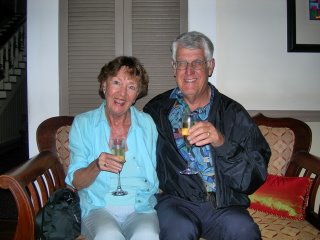
It’s 23:00 and a cool 18C. Back from a fabulous dinner at Hotel Grano de Oro, unexpected for San Jose, the capital of Costa Rica. No major excitement this New Year’s eve – some crackers/fireworks in the distance but few people in the streets. The high rise ICE building next door (the Costa Rica telecom provider I am using) still has flashing illuminated Christmas decorations.
We are listening/viewing, like every night since being near the capital, to a classical music channel featuring vintage film-video footage of great performances of music, ballet, film, etc. Made for US public broadcasting by a visionary American and without ads. Clips from the 1920s-on, and quite the best viewing of the 99 or so stations available here.
Caribbean Coast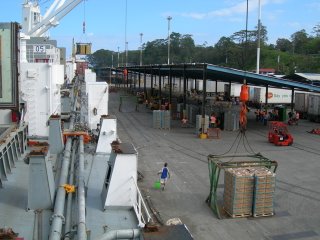
Back to Limon Province, where we arrived just over a week ago. Caribbean coast, banana country, frequent downpours and potholes unlike any we have ever experienced. Driving is a challenge trying to avoid them – and oncoming traffic, people walking, bicycles, and animals.
A few days before our arrival, there was an industrial disaster near Moin, the freighter port next to Puerto Limon, a chemical fire which polluted the nearby spring water supply and was declared a national disaster. The Health Minister called the situation “more than inadequate”.
Tourism police are walking the streets of Puerto Limon and act as guides to boot. They point to sloths in the trees of the central park. The population here is 23% black, mostly of Jamaican origin and African slaves before that. They speak English and came to build the railroad that connected the province to the capital. It was abandoned in the 1990s because of dangerous mud slides. Before the blacks, the Chinese arrived and before them…
The population here is 23% black, mostly of Jamaican origin and African slaves before that. They speak English and came to build the railroad that connected the province to the capital. It was abandoned in the 1990s because of dangerous mud slides. Before the blacks, the Chinese arrived and before them…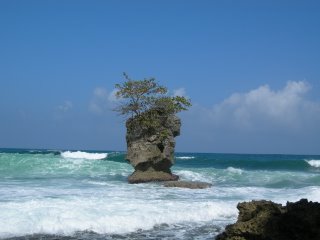
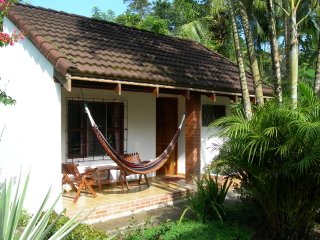
Now the Caribbean coast is a favourite destination of Europeans, Italians in particular - settlers and tourists alike. We stayed in an Italian run casita complex in Puerto Viejo and our favorite restaurant was Italian, with a chef from Trieste who made great gnocchi as well as many other excellent dishes.
One highlight was a visit to La Selva, a private nature reserve in the mountains near the border with Panama. I would normally avoid ventures like that, but in Costa Rica environmentally conscious individuals have bought huge swathes of forest for preservation rather than for development. Francesco, a Catalan nature photographer took us (and a French family of four) on a rather challenging stroll through part of his personal jungle and showed us tiny - and not so tiny - frogs, snakes, birds,  monkeys, etc. He wasn’t too keen on my hiking boots but when I explained that I don’t walk well in rubber boots, he said he would watch out for snakes - which he did, wielding a machete. The bigger nuisance was huge jumping ants (by ant standard) that bit our French companions - above their rubber boots, need I add?
monkeys, etc. He wasn’t too keen on my hiking boots but when I explained that I don’t walk well in rubber boots, he said he would watch out for snakes - which he did, wielding a machete. The bigger nuisance was huge jumping ants (by ant standard) that bit our French companions - above their rubber boots, need I add?
Francesco has photographed in Brazil and in many other countries. His wife Angela is a “primatologue” (primate psychologist) and both of them were with Diane Fossey and the mountain gorillas in Rwanda nine months before she was murdered. We saw the photos on his computer. When we arrived a group of white-faced capuchin monkeys was moving through the forest foraging and jumping from tree to tree. One of the young ones was Quillo, who was brought up by Angela and Francesco like their baby after they adopted him a year ago - apparently he was abandoned in a hotel nearby! They first kept him in the lodge, feeding him with a bottle. Then they built a cage outside the lodge complete with a hammock. After several months, they opened the cage during the day and Quillo started to roam. Then just a couple of months ago he did not return and has now been accepted by his fellow capuchins - to the delight of his foster “parents”.
Half of the year Franceso runs a “snack-frites” stand on the Costa Brava! His lovely assistant Rosa was visiting for two months and made us a delicious lunch after the hike. He told us that he lives on a 3-month residence permit in Costa Rica and when he needs to renew (for another 3 months), he slips across the border to Panama by a back road not far from his reserve for the needed stamp – or gets a taxi driver to make the journey with his passport. Amazing that non-nationals can acquire property so easily – and do.
Back to San Jose Province. The capital is, frankly, not very attractive. Our apartotel (very nice) is next to Sabana, a large park that was the runway/main airport until the early 1950s. It is on the edge of what is now downtown. The terminal/control tower structure is a museum which (no luck) was closed until early January.
We explored the surrounding area. San Jose is at 1350 m and has a pleasantly warm climate. We drove to the famous Volcan Poas some 60 km distant – and at 2.700 m. The climate zones we passed through are amazing. First sugar cane, then coffee cultivation until about 1900 m, next flowers and strawberries, giving way to pastures with grazing cows, cheese production, and temperate forest. This was our second visit to the volcano that is, unusually, viewed from above - but which is almost continuously shrouded in cloud. So for the second time we did not see it but managed a hike in the nearly cloud forest reserve.
Pacific Coast, Tamarindo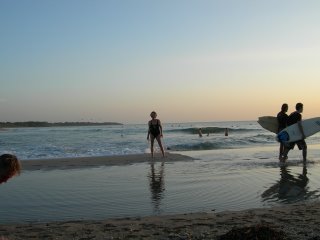
Guanacaste Province northwest on the Pacific coast was our next stop. The Pan American highway is pretty, shaded by trees, narrow and very busy, even on 1 Jan. The road gets quiet and fast once you reach the Nicoya peninsula. The landscape is savanna-like, parts are designated as dry tropical forest (trees drop their leaves during the dry season, December-April) Our destination was Playa de Tamarindo, a famous Costa Rica beach holiday destination featuring surfing, turtle nesting and national parks. AND massive real estate development targeted mainly at Americans.
Starting in December, offshore winds make this area hot and dry, except today the wind has died down and it’s oppressive. We‘re in a large comfortable condo out of Tamarindo on beautiful Langosta beach – and we’re next door to an all-inclusive hotel of the Spanish Barcelo chain which – unwittingly - provides us with useful services: the occasional buffet lunch (we pay for that), wifi in the sitting area, a tour desk - and showers and recycling barrels on the beach (the numerous security guards have learned to tolerate our intrusions). Hotel guests are tagged with green armbands this week.
Watching the Leatherback turtle nesting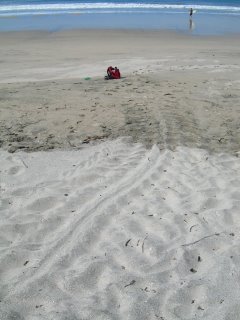
There is a long protected beach near our condo, but it is closed from 18:00 to 06:00. We walked that beach yesterday in the daytime and saw the turtle flipper tracks going from the hard to the soft sand, a little like a caterpillar truck, and then a large indentation in the sand. We also talked to a security person on the beach who was guarding a nest – 12 hours a day.
We have just learned that the official national park tour to observe the leatherback turtle coming ashore to lay her eggs will take place from 18:00 tomorrow Sunday. The timing is a question of darkness (absence of moonlight) and tides, not to mention the turtles being in the mood… For several nights the tours have departed at 23:00 or midnight (and one can be waiting all night to observe a turtle), and since tomorrow Sunday 7 Jan. is our last chance to see this, we are very happy.
We were so lucky! We were ferried over a river to Playa Grande national park (on the other side of Tamarindo) and walked along the beach to the park entrance – high tide and a black, starry night. The commercial part of the tour was somewhat chaotic, but suffice to say that we were in the first group of 16 people that got to see a large leatherback turtle make her nest - hard work with her back flippers - lay 55 eggs and cover up the nest after. That took about 1.5 hours. We only had a 500 m walk to the nesting site, out in starry darkness, return in moonlight. Many on the tour in later groups did not get to see the process because other turtles were too far along the beach - and came much later. The park authorities are well organized: you don’t go to the nesting site until the turtle is up in the soft sand and you are not allowed to stay when she makes the return journey to the sea, because she may not come back. And back they come, each female returns from a nearby area about seven times at a 2-3 day interval to lay up to 100 eggs each time in different nests. However, some eggs are small and not fertilized and out of 1000 eggs, only one or two turtles will survive to adulthood! There are volunteers on site who protect the hatched turtles on the beach but once in the water… Hatching is 60+ days. We saw the egg-laying process with the help of infrared torches (absolutely no photographing allowed), the volunteers were measuring the turtle (she was large, 1.56 m long and 200-300 lbs.) and counting the eggs – even helping to dam the sand she dug up. The leatherback then swims back to the Galapagos. One particular female had not been to the nesting site for 11 years.
While in Tamarindo, we took a sunset sailing trip on the “Mandingo”, a replica of a 19th century schooner – owned by a German born man who sailed it from Marseille across the Atlantic 9 years ago. 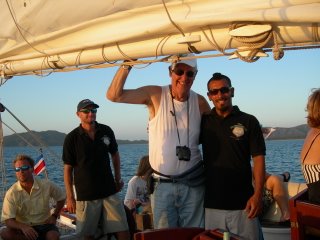
The sea was very rough and we were hanging on and occasionally got soaked, but all the while we were served wine, champagne and other drinks, tapas, fruit and cake by surefooted crew! And we saw a turtle swimming and a whale coming up for air. It was great. I went on their “snorkel express” (a motor boat) another day but the fish were not impressive although we were far away from the tourist beach.
Arenal Province - La Tigra
We are near the active volcano, Arenal, (well, it “glows” at night, but there are currently no major eruptions and the top is in cloud all week) in a temperate rainforest. Really, they do exist! We are only at about 350 m altitude but it gets deliciously cool at times, rains very heavily intermittently and is incredibly lush. All kinds of fruit, vegetables and spices grow, cattle graze, and there are many one-way bridges over the numerous rivers, some very precarious.
We arrived yesterday at this finca with its large garden-jungle.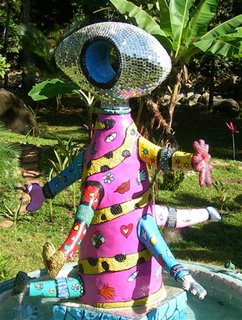 It was built by two men living in San Francisco, one of whom is a Brazilian artist, Regis. We spend hours on a covered terrace overlooking the garden and his Niki de Saint Phalle inspired sculpture which is illuminated and has water sprouting out of its various bits (when we flip the switch). Regis called from SF this morning to see if we were all right and I told him of the similarity. He told me that he is inspired by her work.
It was built by two men living in San Francisco, one of whom is a Brazilian artist, Regis. We spend hours on a covered terrace overlooking the garden and his Niki de Saint Phalle inspired sculpture which is illuminated and has water sprouting out of its various bits (when we flip the switch). Regis called from SF this morning to see if we were all right and I told him of the similarity. He told me that he is inspired by her work. 
At the bottom of the property there is a river and we watch with great fascination the vans and motorbikes crossing to the other side where the road continues up a hill. Sometimes the vans get stuck on the stones in the middle of the river – but they manage to get moving again. There is also a lit footbridge.
The house is a combination of rustic and comfortable. 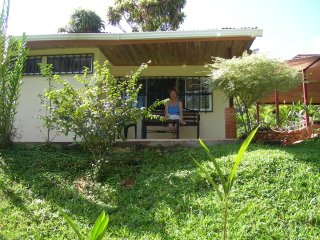 There is a beautiful swimming pool with a (constructed) waterfall on the land, and a “rancho” with a huge barbeque (a big covered seating area above the house).
There is a beautiful swimming pool with a (constructed) waterfall on the land, and a “rancho” with a huge barbeque (a big covered seating area above the house). 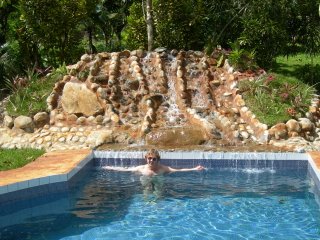
All kinds of fruit grow and Henk prepares bananas for the bird feeding platforms (they grow in the garden and are ripe).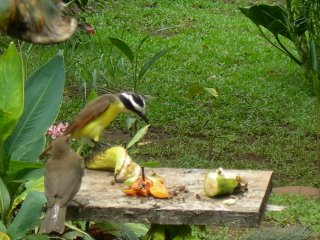
This morning he replenished the fruit three times, he said that the birds were very hungry. He also has time to take early morning walks in the area.
Anita lives across the lane, she is an artist, and Jaime who lives higher up the hill is the caretaker-repairman who shows us how to use the numerous keys, work the lights, open coconuts and more. They watch over us and are lovely people – and their Spanish is very difficult to understand but we manage somehow.
We are in a rural, fertile area, People live modestly but are not poor – there is a real sense of community and they are very friendly. The tourists are 25 km away in La Fortuna. Being tourists, we go there repeatedly for meals, supplies and the hot springs - and the drive is very beautiful.
Neighbour and mechanic Danillo picks us up one morning in his 4WD and drives us up to Poco Sol (Little Sun) at the back of the Monteverde Cloud Forest Reserve. His daughter and our neighbour Anita join us. It is only 12 km but takes an hour on a very steep and muddy dirt road. And we drive across the river at the bottom of the garden – a real thrill, but only the beginning of a drive like no other. We have been to Monteverde before (to the “official” park), it is beautiful but very crowded. Going up the back way, we are the only people there. We hike and Anita shows us tiger, boar, goat and other animal footprints, and we then share a picnic by a lake.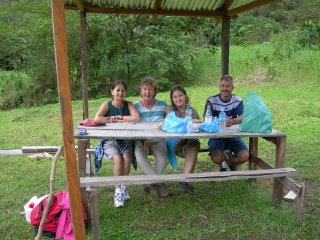
Another day we go on a tour taking us to the border with Nicaragua. We drive past pineapple, sugar cane and teak plantations, then spend three hours on a boat going up the Rio Frio watching birds, caiman and other reptiles. And lunch is a typical Costa Rica cassado (rice, beans and chicken) collected from a local café en route, served buffet style on the boat - with tablecloth and real plates! And our guide is another neighbour from La Tigra!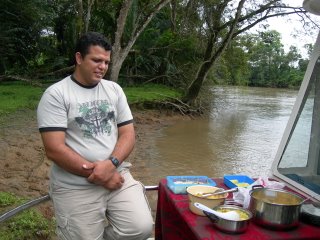
Our one-week stay in La Tigra was magical and we regret having to leave. We drive 2.5 hours to reach the aiport and hand back our rental car, then spend the night at a hotel nearby for an early morning flight home.
Eva, 19 January 2007
